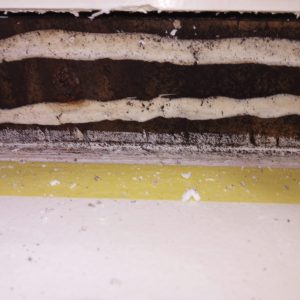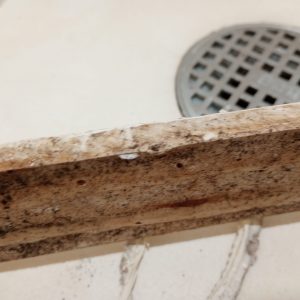There probably aren’t many of you older than I am, but a lot of you been doing this a lot longer than I have.
Some folks asked me to recaulk the pan of their cultured marble shower. When I put a level on the curb, it sloped out from the shower, and some places drastically so. So I decided I needed to take out the caulk at the top of the cultured marble piece that formed the pan on that side. The caulk was all that was holding it in. The curb base behind it was raw 2×6, with no impervious pan of any type. Of course it’s wet, of course there’s mold, it’s what I would expect in the circumstance. The adhesive that held the cultured marble to the 2×6 had long since dissolved. But I have a question. This shower is about 20 years old. Would it have been typical for somebody to do something like that without putting in a PVC pan at that point in time?
Thanks.
Further update:
The ‘pan’ of this shower is just the preformed sloped drain that you stand on. The wall panels go right down to it. I don’t know what it looks like behind those panels.
The curb is untreated 2X4s, with a layer of plywood on the shower side. There was a piece of cultured marble on that, which formed the curb side of the pan. It is damp all the way across, and we’ve got some mold.
The piece of cultured marble on the top of the curb seems to slope away from the drain for pretty much its whole length, more drastically in some places than others. That could, of course, be the result of swelling of the wood in the curb over time. Regardless, at one end of the curb there is a drastic slope toward the join of the wall panel, the curb and the door track system, the absolutely most vulnerable place in the whole shower. And that’s where the worst of the water infiltration has occurred.
This thing is about 20 years old, and I’m afraid I’m going to tell them that if it were in my house, it would be gone. It would take a long time for the curb wood to evaporate, and it’s not ever going to regain its former shape. I might be able to remove and rebuild the curb, but even if I do that, I don’t think I can ever secure the various areas well enough to avoid the problem.






















Replies
It's possible that the shower was installed without a PVC pan 20 years ago. Back then, it may not have been as common for builders and contractors to use PVC pans in shower installations. However, it's important to note that a properly installed PVC pan can greatly reduce the risk of water damage and mold growth in a shower, so it's always a good idea to use one.
If you're repairing the shower now, it may be worth considering installing a new PVC pan to ensure that it is properly waterproofed and protected against future damage. You may also want to check for any other potential issues, such as water damage to the framing or insulation, and address those as well to ensure that the shower is safe and functional for years to come.
Thanks for the input. I put more info in the original post.
There isn't any way for me to put in a membrane pan.
You will have to cut out about the lower 2ft of the walls and then you can install a PVC pan or put a liner in and make a complete new pan you might have to change the sub floor and inspect the wall studs very well